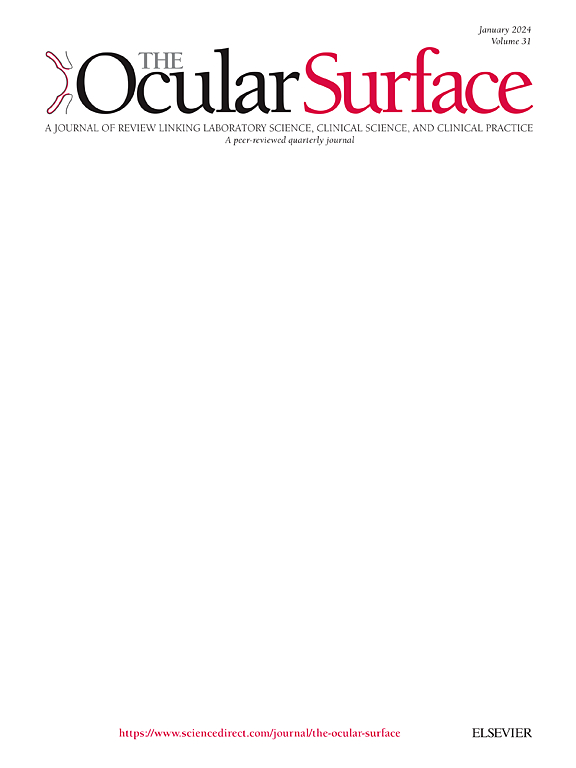神经病变性角膜疼痛与干眼综合征鉴别的影像学及分子标志物探讨。
IF 5.6
1区 医学
Q1 OPHTHALMOLOGY
引用次数: 0
摘要
目的:探讨神经性角膜疼痛(NCP)和干眼病(DED)的影像学、临床和泪液蛋白质组学特征,并寻找区分NCP和DED的潜在影像学和分子生物标志物。方法:本横断面研究纳入54例NCP患者(105眼)、53例DED患者(106眼)和54例健康对照(108眼)。通过眼表评估、眼痛评估调查(OPAS)和体内共聚焦显微镜对所有受试者进行评估,以表征角膜神经、微神经瘤(MNs)、免疫细胞和上皮细胞。泪液定量蛋白质组学分析。结果:NCP组MNs的出现率、数目、总面积、周长及平均面积均显著高于其他两组。NCP患者角膜神经纤维宽度明显增高。MNs参数与OPAS评分显著相关(r=0.20 ~ 0.48)。结论:与DED患者相比,NCP患者表现出不同的影像学特征、临床特征和蛋白质组学特征。这些可以用作区分指标。本文章由计算机程序翻译,如有差异,请以英文原文为准。
Exploration of imaging and molecular biomarkers for differentiation of neuropathic corneal pain from dry eye syndrome
Purpose
To investigate the imaging, clinical, and tear proteomic profiles between neuropathic corneal pain (NCP) and dry eye disease (DED), and to identify potential imaging and molecular biomarkers for the differentiation of NCP from DED.
Methods
This cross-sectional study included 54 NCP patients (105 eyes), 53 DED patients (106 eyes), and 54 healthy controls (108 eyes). All subjects were evaluated with ocular surface assessment, ocular pain assessment survey (OPAS), and in-vivo confocal microscopy to characterize corneal nerves, microneuromas (MNs), immune cells, and epithelial cells. Tear quantitative proteomics were analyzed.
Results
The percentage of presence of MNs, the number, total area, total perimeter, and average area of MNs were significantly higher in the NCP group than the other two groups. NCP patients had significantly higher corneal nerve fiber width. MNs parameters were significantly correlated with the OPAS scores (r = 0.20 to 0.48, all P < 0.05). Particularly, in peripheral NCP, both MNs total area and perimeter exhibited a significant correlation with the OPAS eye pain intensity (r = 0.55–0.57, both P < 0.05). Combinations of MNs parameters and OPAS scores had high diagnostic efficacy for NCP with an area under the curve (AUC) of 0.916. A total of 129 significantly differential proteins were identified, such as up-regulated vinculin and down-regulated DLG associated protein 4 in NCP, as well as up-regulated S100A12 and matrix metallopeptidase 9 in DED. These dysregulated proteins were linked to neuron apoptosis, inflammatory response, and synaptic transmission.
Conclusion
NCP patients present with different imaging features, clinical characteristics and proteomic profiles, compared with DED patients. These can be used as differentiating indicators.
求助全文
通过发布文献求助,成功后即可免费获取论文全文。
去求助
来源期刊

Ocular Surface
医学-眼科学
CiteScore
11.60
自引率
14.10%
发文量
97
审稿时长
39 days
期刊介绍:
The Ocular Surface, a quarterly, a peer-reviewed journal, is an authoritative resource that integrates and interprets major findings in diverse fields related to the ocular surface, including ophthalmology, optometry, genetics, molecular biology, pharmacology, immunology, infectious disease, and epidemiology. Its critical review articles cover the most current knowledge on medical and surgical management of ocular surface pathology, new understandings of ocular surface physiology, the meaning of recent discoveries on how the ocular surface responds to injury and disease, and updates on drug and device development. The journal also publishes select original research reports and articles describing cutting-edge techniques and technology in the field.
Benefits to authors
We also provide many author benefits, such as free PDFs, a liberal copyright policy, special discounts on Elsevier publications and much more. Please click here for more information on our author services.
Please see our Guide for Authors for information on article submission. If you require any further information or help, please visit our Support Center
 求助内容:
求助内容: 应助结果提醒方式:
应助结果提醒方式:


